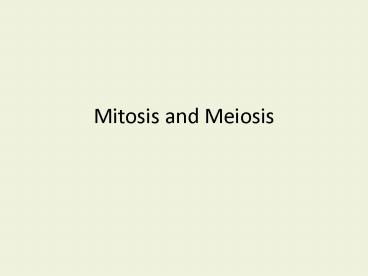Mitosis and Meiosis - PowerPoint PPT Presentation
1 / 26
Title:
Mitosis and Meiosis
Description:
Mitosis and Meiosis Chromosomes are made up of DNA which carries the cells genetic information Human body cells have 46 chromosomes (in 23 pairs) Sex cells (gametes ... – PowerPoint PPT presentation
Number of Views:129
Avg rating:3.0/5.0
Title: Mitosis and Meiosis
1
Mitosis and Meiosis
2
Chromosomes
Sister Chromatids
- Chromosomes are made up of DNA which carries the
cells genetic information - Human body cells have 46 chromosomes (in 23
pairs) - Sex cells (gametes aka egg and sperm) only have
23 chromosomes - Before cell division occurs, each chromosome
replicates (or copies itself)
Centromere
3
Cell Growth and Division
- Cell Cycle is a series of events that cells go
through as they grow, prepare for division and
divide into two identical daughter cells - Two major stages in a cells life are
- Interphase
- M Phase or cell division
4
Interphase
- Interphase is the phase where the cell grows and
prepares to divide. - Interphase is divided into three phases
- G1 Phase - growth
- S Phase replication (copying) chromosomes
- G2 Phase further growth
- A lot is happening during G1, S and G2 phases!
5
M Phase
- M Phase is cell division which includes two
steps - Mitosis- this is division of the nucleus
- Cytokinesis this is division of the cytoplasm
6
Mitosis
- Mitosis is divided into four phases
- Prophase chromosomes condense, becoming
visible centrioles move to opposite sides of
nucleus nuclear envelope dissolves - Metaphase chromosomes line up across middle of
cell - Anaphase sister chromatids split
- Telophase - sister chromatids move to opposite
sides of cell and new nuclear envelopes form
7
(No Transcript)
8
Cytokinesis
- Cytokinesis is occurring at the same time as
telophase - The cell membrane pinches the cytoplasm into two
equal parts. - Two new daughter cells are now formed and are
genetically identical to the parent cell. - This is the end of the cell cycle.
9
MEIOSIS
- Meiosis is process where the number of
chromosomes per cell is divided in half by
separating homologous chromosomes in a diploid
cell. - Gametes
- are produced by meiosis.
- What does all that mean???
10
- Chromosomes are made up of DNA which carries the
cells genetic information - Genes are found on the chromosomes.
- Genes are chemical factors that determine traits.
(Ex. Eye color, hair color, height, etc.) - Different forms of a gene are called alleles
- (Ex. Blue or brown eyes, brunette or auburn)
- The symbol N represents the number of
chromosomes in a gamete (sex cell)
11
- Homologous chromosome means that each chromosome
that comes from the male has a corresponding
chromosome from the female - Homologous chromosome have DNA segments, or
genes, for the same trait
12
- Diploid cells have both sets of homologous
chromosomes (one set from momma and one from the
babys daddy) - All cells in your body (except egg and sperm) are
diploid - These cells are called somatic cells
- 2N
13
- Haploid cells have half the number of chromosomes
as their parent cells - Gametes (egg and sperm) are haploid
- Gametes are genetically different than the parent
cell and one another - N
14
N
N
N
2N
N
N
N
15
- Human has 46 chromosomes. How many chromosomes
in human gametes? - 23
- Pineapple has 25 chromosomes in its gametes.
What is its haploid number? - 25
- A giraffe has a diploid number of 62. What is
its haploid number? - 31
16
Draw this!
46
17
First Step
- Replication
- During meiosis, chromosomes are replicated once
in S phase (just like mitosis) into sister
chromatids. - This occurs so that each of the 46 chromosomes
exists as a duplicated sister chromatid.
18
Meiosis I
- HOMOLOGUES (1-23) are segregated into different
cells. - Results in 2 cells that each have 1 copy of each
of the 23 chromosomes (still duplicated from DNA
replication).
19
Prophase I
- Crossing over
- Homologous chromosomes in the cell pair up
alongside each other lengthwise forming a tetrad - Swap bits and pieces of their chromosomes,
shuffling the genome - Results in NEW Chromosomes that did not exist
before in the parent
20
(No Transcript)
21
Meiosis II
- SISTER CHROMATIDS of each of the 23 chromosomes
are pulled apart just as they are in mitosis - Results in 4 cells that have 1 copy of each of
the 23 chromosomes (now unduplicated again) - Now officially haploid
22
(No Transcript)
23
Meiosis occurs in two stages
- Meiosis I
- Two cells form with sets of chromosomes and
alleles that are different from each other - Meiosis II
- Cells divide again without DNA replication
forming four cells with half the number of
chromosomes of the parent cell
24
Summary of Mitosis/Meiosis
- Mitosis
- Results in 2 identical cells that are diploid
(2N) and are exactly like the parent cell - Meiosis
- Results in 4 cells that have half the number of
chromosomes, haploid (N), as the parent cell and
are genetically different from one another - Genetic Recombination
25
Meiosis Square Dance
26
- Linked Genes - Genes located closely together are
linked - Crossing over is more likely to occur between
genes that are far apart rather than linked which
are close together. - Polyploidy The occurrence of one or more extra
chromosomes in an organism. - This is not good in animals but is beneficial in
plants (crop plants are stronger and bigger)































